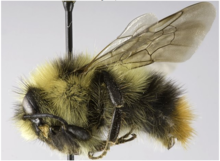Frigid bumblebee
| Bombus frigidus | |
|---|---|
 |
|
| Scientific classification | |
| Kingdom: | Animalia |
| Clade: | Euarthropoda |
| Class: | Insecta |
| Order: | Hymenoptera |
| Family: | Apidae |
| Genus: | Bombus |
| Subgenus: | Pyrobombus |
| Species: | B. frigidus |
| Binomial name | |
|
Bombus frigidus Smith, 1854 |
|
 |
|
Bombus frigidus, the frigid bumblebee, is a rare species of bumblebee largely found in Canada and parts of the United States.
These bees have adapted to their cold environment by being able to keep their internal temperature within a certain range while also being able to expel heat to keep the colony warm. An additional adaptation to the cold is their reduced length of copulation. Also, B. frigidus has developed a relationship with Mertensia paniculata so that the flowers' color signals to the bees when to obtain nectar.
Bombus frigidus was discovered in 1854 by Frederick Smith and was catalogued in Catalogue of hymenopterous insects in the collection of the British Museum, which was published in 1859. Some species from the Appalachians have been included with this species in the past, but not in newer sources. This bee can be confused with Bombus mixtus and Bombus balteatus. Bees in the family Apidae consist of honey bees, bumblebees, and stingless bees.
Bombus frigidus have a yellow thorax and T1-T2. T1-T5 refers to the dorsal abdomen of the bee with T1 being closer to the thorax-abdomen division. A black band is present between the wings (the band may not be there for some males). The T4-T5 are orange or yellow. The hair of the face is black for females (can be black or yellow for males). The corbicular fringe (pollen sack near the back of the bee) is pale orange. The hair length is long, and the males are roughly half the size of the queen. The hair on the legs for both sexes is black.
Bombus frigidus is a rare bee that is found from Alaska to the eastern shore of Canada, and as far south as Colorado. There have been erroneous reports of the bee being spotted in California, Ohio, Tennessee, North Carolina and Virginia. These arctic bees live in cold, high latitude or altitude areas. Their colonies are formed either in small burrows or on the ground. Despite being rare, their populations are not decreasing like other bumblebees, and they are considered of “Least Concern” in terms of conservation status.
...
Wikipedia

